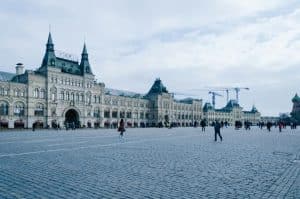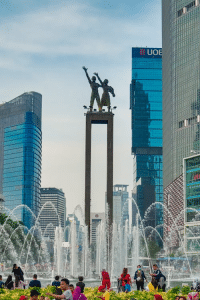In early September, China announced that starting September 15, it would implement a trial visa-free policy (30 days, valid for one year) for holders of ordinary Russian passports, marking a new phase in people-to-people exchanges between China and Russia.
Meanwhile, over the past two years, China has also gradually expanded mutual visa-free arrangements with countries like Singapore and Malaysia. Such international travel facilitation policies may seem “merely convenient for tourism,” but amid globalization and the reshaping of geopolitical and economic structures, their macro-level impact extends far beyond border checkpoint queue lengths.
They involve the reconfiguration of trade, investment, industrial chains, soft power, and geopolitical strategies.

I. China-Russia Visa-Free Travel:
Economic and Strategic Implications Behind the “Tourism” Facade
1. China Announces Visa-Free Access for Russia
Recently, China’s Ministry of Foreign Affairs announced a one-year trial visa-free policy for holders of ordinary Russian passports, effective September 15, 2025, allowing stays not exceeding 30 days per visit.
https://v.qq.com/x/page/e3170yc3jio.html
👆Video Source: CCTV News, Remove if Infringing
Subsequently, Russian President Putin indicated that Russia would reciprocate with a visa-free policy or mutual exemption.
https://v.qq.com/x/page/b31703lw61w.html
👆Video source: CCTV News, rights reserved
2. Direct Economic Impact:
① Tourism and Consumption Revival
Visa-free access typically stimulates immediate growth in tourist numbers and short-term spending. For mainland China, Russian tourists contribute significantly to urban attractions, shopping, and cross-border e-commerce (tax-free shopping, duty-free stores). This will boost demand in hotels, dining, retail, and transportation sectors, accelerating the recovery of service industries.
Historical data shows that visa facilitation and route restoration can significantly boost visitor numbers and air ticket demand in the short term, directly benefiting aviation and tourism supply chains (including low-cost routes and regional transit hubs).
② Trade and Industrial Chain Synergy
Easier personnel movement amplifies the frequency of business, inspection visits, and cooperation among SMEs. Russia holds advantages in energy, agricultural products, and heavy equipment, while China possesses scale and market presence in manufacturing, electronics, and consumer goods. Mutual visa agreements will facilitate small-scale trade and local-level investment matching, fostering “point-to-point” growth particularly in border regions and areas like Northeast China and the Russian Far East.
For supply chain resilience, this could serve as a pathway to diversify risks from Western markets while generating competitive and substitution effects in certain sectors (e.g., restructuring trade routes for energy and agricultural products).
③ Financial and Capital Flows
Easier personnel movement could boost cross-border exhibitions, negotiations, and project due diligence frequency, thereby generating more small-to-medium direct investment and M&A deals. However, larger capital flows remain constrained by foreign exchange controls, sanctions, and the institutional environment of international financial linkages—factors that visa-free travel alone cannot fully alter. In other words, visa-free access acts as a “catalyst” rather than a “decisive switch.”
④ Geopolitical Security and Soft Power Impact
The recent security alignment between China and Russia lends visa-free travel symbolic significance: it reflects bilateral mutual trust while signaling to third parties that both nations are willing to lower barriers for personnel exchanges to deepen their strategic partnership.
In the short term, such moves may prompt third countries engaged with both nations to carefully reassess the balance of their relations with China and Russia. However, long-term effects will depend on whether economic interactions genuinely deepen and on policy responses from Western nations (e.g., restrictions on certain types of personnel exchanges).

Source: CCTV News, removed if infringing
3. Risks and Challenges
While visa-free travel offers benefits, it also brings regulatory and enforcement pressures: increased border management, entry/exit security, and potential issues with illegal employment and overstaying.
On the other hand, Sino-Russian cooperation under financial sanctions could expose businesses and financial institutions to compliance risks if it involves sanctioned entities.
Therefore, policy design typically adopts a “pilot program + short-term stays + strict oversight” approach to balance convenience and security.

Source: Pexels

II. Singapore, Malaysia, Thailand:
What Real-World Changes Did Visa-Free Access Bring?
1. Singapore: High-Frequency Business and “Quality Tourist” Strategy
① Visa-Free Stay: Chinese citizens holding ordinary passports may enter Singapore visa-free for stays not exceeding 30 days per visit.
② Applicable Purposes: Tourism, family visits, business, and other private matters.
③ Exclusions: Activities requiring prior approval (e.g., work, study, journalism) or stays exceeding 30 days (requires obtaining the appropriate visa in advance). Additionally, entry must comply with Singaporean laws, such as cigarette import limits (19 sticks) and prohibited items (e.g., illegal meat products).
As a regional financial and MICE hub, Singapore’s most immediate impact from China’s visa waiver is increased business and conference mobility.
Increased short-to-medium term business exchanges will boost growth in financial services, exhibitions, educational exchanges, and medical tourism. Simultaneously, as Singapore has long attracted high-net-worth visitors, visa-free access will also facilitate expansion in luxury consumption and professional services (e.g., wealth management, medical aesthetics).
Singapore’s robust border control, urban capacity, and mature regulatory framework enable it to strike a balanced approach between “facilitating visits” and “maintaining order.”

Fig: Singapore’s Merlion
2. Malaysia: Amplifier for Tourism and Regional Connectivity
① Visa-Free Stay: Up to 30 days per entry, with a cumulative stay not exceeding 90 days within any 180-day period.
② Applicable Activities: Leisure travel, visiting relatives/friends, business activities, exchange visits, personal affairs, medical treatment, international transportation (crew members).
③ Ineligible Activities: Activities requiring prior approval (e.g., employment, study, journalism, settlement) or stays exceeding 30 days per visit require corresponding visa applications.
The mutual visa exemption between Malaysia and China has yielded significant effects in tourism, passenger transport, and local retail. Malaysia’s strong natural and cultural tourism appeal typically amplifies visitor flows during holiday seasons under visa-free arrangements, driving demand for multi-destination tours across Southeast Asia (e.g., “Singapore-China-Malaysia Connect” multi-country travel products).
Additionally, Malaysia possesses complementary strengths in manufacturing and food processing. The visa waiver creates more opportunities for SMEs to conduct business visits, technical exchanges, and small-to-medium investments.

Source: Pexels
3. Thailand: Tourism Recovery and Variables
① Visa-Free Stay: Chinese citizens holding valid ordinary passports visiting Thailand, and Thai citizens visiting China, may stay visa-free for up to 30 days per visit, with a cumulative stay not exceeding 90 days within any 180-day period.
② Scope of Application: This policy applies to short-term visits for tourism, family visits, business, etc. Activities requiring prior approval—such as work, study, or settlement—or stays exceeding 30 days still necessitate obtaining the corresponding visa before entry.
③ Policy Significance: This measure facilitates short-term exchanges between citizens of both countries, promoting tourism and other forms of interaction. Note that “visa-free” does not equate to unlimited long-term residence; strict adherence to the stipulated stay limits is mandatory.
Thailand, heavily reliant on tourism, views visa facilitation as a key tool to attract returning international visitors.
However, Thailand’s frequent policy shifts amplify uncertainty: In 2025, Prime Minister Anutin Charnvirakul assumed office, known for pragmatism and cross-faction maneuvering, with prior governance experience in health and industrial sectors.
Should Thailand prioritize stability and promote tourism and investment openness, it could leverage visa-free access and tourism recovery to sustain economic growth in the short term. Conversely, social instability may deter long-term foreign investment and high-end tourism returns. For visitors and investors, monitoring the continuity of Thailand’s tourism governance, public safety, and visa policies is crucial.

Source: Pexels
*Comprehensive Observations: The Singapore model demonstrates that “visa-free access + high-standard services + robust regulations” can convert visitors into high-value economic activity; Malaysia shows that “visa-free access leads to tourist growth, but requires infrastructure upgrades”; Thailand once again proves tourism is highly variable, with policy dividends needing societal and governance continuity to materialize.

III. Why Doesn’t Japan Offer Reciprocal Visa-Free Access?
Do Indonesia and Vietnam grant visa-free entry to Chinese citizens?
In reality, reciprocal visa-free access hinges on three dimensions—legal frameworks, public security, and economic policies—rather than simplistic notions of “granting visas to friendly nations.”
1. China grants visa-free access to Japan, but why doesn’t Japan reciprocate?
First, we must distinguish between two types of “visa-free access”: mutual exemption (true reciprocity) and unilateral relaxation or entry permits for specific groups (e.g., professionals, business travelers). Mutual visa-free access with Japan is constrained by the following factors:
① Border management and entry risk assessment
Japan maintains stringent security protocols for short-term visitors, including identity verification and concerns over overstay records. Mutual visa exemption becomes challenging if either side perceives gaps in the other’s immigration records or identity verification systems.
② Bilateral and Historical Sensitivities
Despite strong economic complementarity, historical and geopolitical issues persistently influence mutual trust and public sentiment. Visa reciprocity often requires significant stability and progress in bilateral dialogue.
③ Reciprocity and Domestic Policy
Japan’s domestic considerations for easing entry restrictions involve public sentiment and industrial concerns (e.g., worries about low-skilled labor influx and social pressures). Therefore, even if China opens its borders, Japan must decide whether to reciprocate with equivalent visa-free access based on its own domestic context.
Consequently, situations where one side eases restrictions unilaterally without reciprocal action are not uncommon in the short term. Whether mutual visa-free access is ultimately achieved depends on comprehensive assessments of immigration management, public security, labor markets, and policy trust between the two parties.

Source: Pexels
2. Why are Southeast Asian countries like Indonesia and Vietnam cautious?
Countries such as Indonesia and Vietnam adopt more prudent visa policies primarily due to:
① Labor Market Protection
While welcoming foreign tourists and businesspeople, these nations must also guard against illegal employment and transnational labor brokerage issues. They thus prefer maintaining certain barriers to protect domestic employment and social order.
② Variations in Immigration Management Capabilities
Visa reciprocity requires high-level information exchange (e.g., border data sharing, criminal record exchanges). Without sufficient mutual trust and technical support in these areas, mutual exemption becomes difficult to implement.
③ Differing Fiscal and Tourism Strategies
Some nations utilize visa fees and entry procedures as components of fiscal or tourism management. Directly abolishing visas could disrupt revenue structures or urban capacity strategies.
④ Diplomatic Bargaining Chip
Visa reciprocity often serves as a clause in bilateral negotiations. If sufficient mutual trust hasn’t been established between countries on trade, territorial, or other issues, visa facilitation may be delayed or used as a bargaining condition.
In summary, Indonesia and Vietnam’s cautious approach stems more from institutional constraints and national strategic choices than mere “isolationism.”

Source: Pexels

IV. China’s Visa-Free Agreements with Multiple Countries
What Impact Will This Bring?
Singapore, Malaysia, and Thailand have already implemented comprehensive visa-free access for Chinese citizens, while Russia has announced it will soon establish reciprocal visa-free arrangements with China. This series of visa facilitation measures is generating multi-layered positive impacts on regional economic cooperation and global cultural and tourism exchanges.
1. Economic Aspects
At the economic level, visa-free policies significantly reduce the institutional and time costs of business exchanges. The China-Russia visa-free arrangement is projected to boost bilateral investment by 15%-20% during the pilot phase, creating more favorable conditions for deepened cooperation between enterprises in energy, manufacturing, technological innovation, and other sectors.
Simultaneously, the removal of travel barriers between China and Southeast Asian nations has further optimized regional supply chain resource allocation and strengthened industrial chain collaboration. These measures have also generated a positive “demonstration effect,” encouraging more countries to consider easing visa restrictions for Chinese travelers, thereby promoting broader economic and trade interactions.

Source: Pexels
2. Cultural and Tourism Sector
In the cultural and tourism industry, visa-free policies have yielded immediate market effects. During the 2025 Spring Festival period, Chinese tourists to Singapore surged by over 960% year-on-year, while Malaysia welcomed 1.12 million Chinese visitors in the first quarter alone.
Beyond traditional hotspots, the visa-free policy has spurred emerging tourism routes, significantly boosting the appeal of destinations like Russia’s Lake Baikal region and China’s Lijiang in Yunnan Province.
More notably, tourism patterns are undergoing profound transformation:
The shift from pastiche sightseeing to immersive experiential travel—including cultural courses and border life experiences—is gaining popularity. This transformation not only boosts border economic development but also fosters deeper cultural exchanges.
A language learning boom has followed suit: nearly 100 Russian primary and secondary schools now offer Chinese as a compulsory subject, while over 150 Chinese universities have established Russian language programs.
These visa-free policies are tangible manifestations of enhanced mutual trust between nations and crucial measures for advancing regional economic integration and cultural convergence. By lowering barriers to people-to-people exchanges, they not only boost economic cooperation and tourism development but also build bridges for dialogue and understanding between civilizations, holding profound significance for promoting connectivity across regions and the globe.

Source: Pexels
Conclusion:
Visa facilitation serves as a “low-cost lever” connecting nations in the 21st century: it rapidly amplifies exchanges, streamlining commercial opportunities, cultural mutual learning, and personnel mobility. Yet it also challenges national governance capabilities, regulatory coordination, and geopolitical resilience.
The visa-free arrangements between China and Russia, as well as those between China and countries like Singapore, Malaysia, and Thailand, offer a window of observation: while policy dividends can stimulate consumption and exchanges in the short term, whether they can be converted into long-term structural economic gains ultimately depends on institutional support and policy stability.
For enterprises and local entities, the current window presents an opportunity to “act swiftly while remaining rational and prudent.”
Note: References sourced from China Visa Centers, CCTV News, China News Network, Phoenix New Media, Singapore ICA, Lianhe Zaobao, and comprehensive news media reports. Reproduction requires attribution; contact for removal if infringing…….
